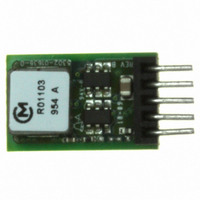OKR-T/3-W12-C Murata Power Solutions Inc, OKR-T/3-W12-C Datasheet - Page 7

OKR-T/3-W12-C
Manufacturer Part Number
OKR-T/3-W12-C
Description
CONV DC/DC 15W 12VIN SIP
Manufacturer
Murata Power Solutions Inc
Series
Okami™ OKR-T/3r
Type
Point of Load (POL) Non-Isolatedr
Specifications of OKR-T/3-W12-C
Number Of Outputs
1
Output
0.59 ~ 6V
Power (watts)
15W
Mounting Type
Through Hole
Voltage - Input
4.5 ~ 14V
Package / Case
5-SIP Module
1st Output
0.59 ~ 6 VDC @ 3A
Size / Dimension
0.41" L x 0.30" W x 0.65" H (10.4mm x 7.6mm x 16.5mm)
Power (watts) - Rated
15W
Efficiency
93%
Approvals
cUL, EN, UL
Output Power
18 W
Input Voltage Range
4.5 V to 14 V
Input Voltage (nominal)
12 V
Output Voltage (channel 1)
0.591 V to 6 V
Output Current (channel 1)
3 A
Package / Case Size
SIP
Output Type
DC/DC Converter
Output Voltage
0.591 V to 6 V
Product
Non-Isolated / POL
Output Current
3A
Input Voltage
12V
Mounting Style
Through Hole
Pin Count
5
Lead Free Status / RoHS Status
Lead free / RoHS Compliant
Operating Temperature
-
3rd Output
-
2nd Output
-
Lead Free Status / Rohs Status
Lead free / RoHS Compliant
Other names
811-2115-5
All models regulate within specifi cation and are stable under no load to full
load conditions. Operation under no load might however slightly increase
output ripple and noise.
To prevent many over temperature problems and damage, these converters
include thermal shutdown circuitry. If environmental conditions cause the
temperature of the DC/DC’s to rise above the Operating Temperature Range
up to the shutdown temperature, an on-board electronic temperature sensor
will power down the unit. When the temperature decreases below the turn-on
threshold, the converter will automatically restart. There is a small amount of
hysteresis to prevent rapid on/off cycling. The temperature sensor is typically
located adjacent to the switching controller, approximately in the center of the
unit. See the Performance and Functional Specifi cations.
shut down suddenly without warning. Be sure to thoroughly test your applica-
tion to avoid unplanned thermal shutdown.
The graphs in the next section illustrate typical operation under a variety of
conditions. The Derating curves show the maximum continuous ambient air
temperature and decreasing maximum output current which is acceptable
under increasing forced airfl ow measured in Linear Feet per Minute (“LFM”).
Note that these are AVERAGE measurements. The converter will accept brief
increases in current or reduced airfl ow as long as the average is not exceeded.
itself which is obviously running at higher temperature than the outside air.
Also note that very low fl ow rates (below about 25 LFM) are similar to “natural
convection”, that is, not using fan-forced airfl ow.
cycle wind tunnel with calibrated airfl ow. We use both thermocouples and an
infrared camera system to observe thermal performance.
the converter may have an unplanned Over Temperature shut down. Also, these
graphs are all collected at slightly above Sea Level altitude. Be sure to reduce
the derating for higher density altitude.
CAUTION: If you operate too close to the thermal limits, the converter may
Note that the temperatures are of the ambient airfl ow, not the converter
Murata Power Solutions makes Characterization measurements in a closed
+OUTPUT
-OUTPUT
If you routinely or accidentally exceed these Derating guidelines,
Figure 5: Measuring Output Ripple and Noise (PARD)
C1 = 0.1μF CERAMIC
C2 = 10μF TANTALUM
LOAD 2-3 INCHES (51-76mm) FROM MODULE
C1
COPPER STRIP
COPPER STRIP
C2
SCOPE
www.murata-ps.com
R
LOAD
Current limiting inception is defi ned as the point at which full power falls below
the rated tolerance. See the Performance/Functional Specifi cations. Note par-
ticularly that the output current may briefl y rise above its rated value in normal
operation as long as the average output power is not exceeded. This enhances
reliability and continued operation of your application. If the output current is
too high, the converter will enter the short circuit condition.
When a converter is in current-limit mode, the output voltage will drop as the
output current demand increases. If the output voltage drops too low (approxi-
mately 98% of nominal output voltage for most models), the magnetically
coupled voltage used to develop primary side voltages will also drop, thereby
shutting down the PWM controller. Following a time-out period, the PWM will
restart, causing the output voltage to begin ramping up to its appropriate value.
If the short-circuit condition persists, another shutdown cycle will initiate. This
rapid on/off cycling is called “hiccup mode”. The hiccup cycling reduces the
average output current, thereby preventing excessive internal temperatures
and/or component damage. A short circuit can be tolerated indefi nitely.
because you do not have to power down the converter to make it restart. The
system will automatically restore operation as soon as the short circuit condi-
tion is removed.
Please refer to the Connection Diagram on page 1 for On/Off connections.
pulled high to +Vin with respect to –Vin. Positive-polarity devices are disabled
when the On/Off is grounded or brought to within a low voltage (see Specifi ca-
tions) with respect to –Vin.
signal current when brought low and withstand appropriate voltage when
brought high. Be aware too that there is a fi nite time in milliseconds (see
Specifi cations) between the time of On/Off Control activation and stable,
regulated output. This time will vary slightly with output load type and current
and input conditions.
These converters do not require external capacitance added to achieve rated
specifi cations. Users should only consider adding capacitance to reduce
switching noise and/or to handle spike current load steps. Install only enough
capacitance to achieve noise objectives. Excess external capacitance may
cause regulation problems, degraded transient response and possible oscilla-
tion or instability.
Adjustable Output 3-Amp SIP-mount DC/DC Converters
The “hiccup” system differs from older latching short circuit systems
Positive polarity models are enabled when the On/Off pin is left open or is
Dynamic control of the On/Off function should be able to sink appropriate
Page 7 of 11
























